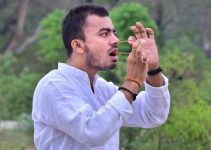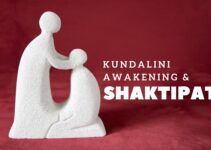- Swami Sivananda
- T. Krishnamacharya
- Yogananda
- K. Pattabhi Jois
- B.K.S. Iyengar
- Maharishi Mahesh Yogi
- Swami Rama
- Sri Sri Ravi Shankar
- Sadhguru
- Baba Ramdev
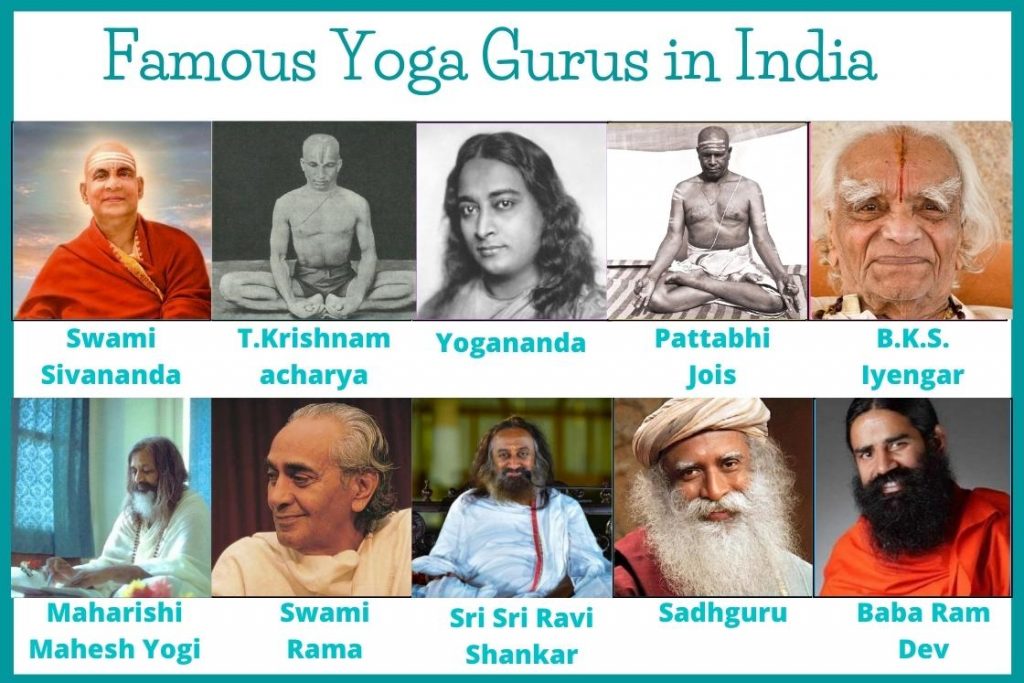
In ancient times, yoga was not accessible to everyone and it was not easy to learn, as it has become today. Yoga has a history of about 5000 years. Many generations have passed, passing this knowledge from the Guru-Shishya Parampara (Teacher-Disciple tradition) in ancient India to the modern-day online Yoga.
If today you can start your yoga practice without a second thought – at your convenience, it has become possible only because of some yoga gurus who made yoga accessible to everyone.
However, the history of yoga is long back in time, but it prominently started gaining limelight in the modern world in late 19th century.
Swami Vivekananda is credited as one of the earlier gurus of modern yoga who popularized yoga in the western world. It was 1893 when Swami Vivekananda presented yoga as a “science of the mind” in the Parliament of Religions, Chicago. Since then, many yoga gurus of India emerged as world-renowned masters.
Today in this article, we are going to look at the 10 famous yoga gurus and spiritual masters who have struggled and succeeded to receive this age-old tradition.
1. Swami Sivananda Saraswati (1887 – 1963)
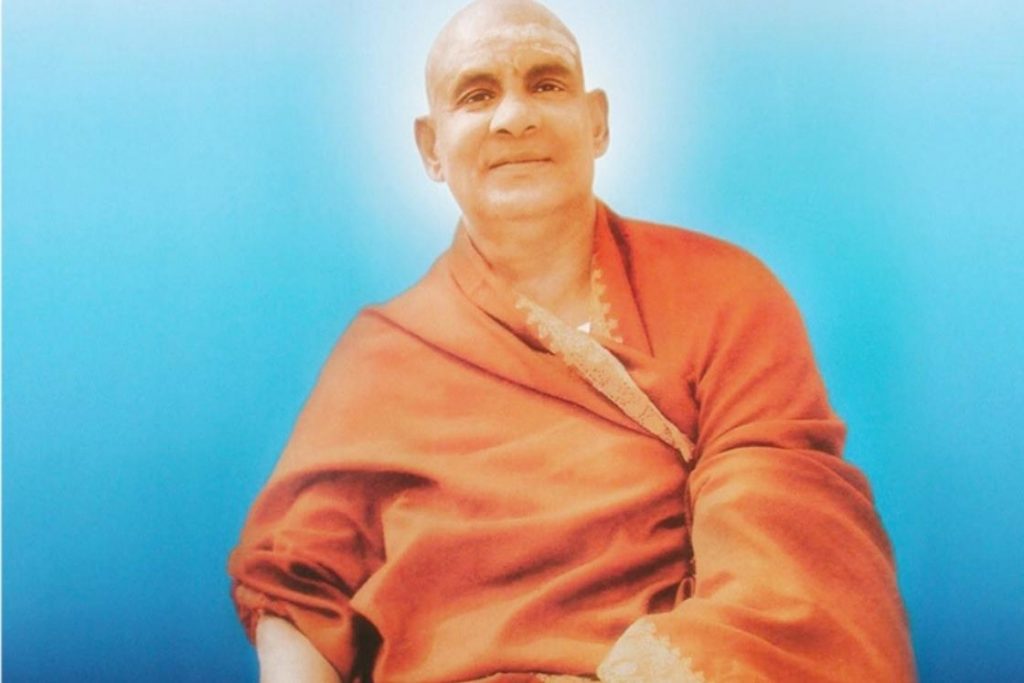
Life Story
On September 8, 1887, Swami Sivananda was born in a Brahmin household in Kuppuswami, Tamil Nadu. He was a very active and bright student and gymnast as a child.
In Tanjore, Tamil Nadu, he studied medicine and graduated with honors. During this time, he published the Ambrosia medical journal.
He practised medicine and served as a doctor in British Malaya (a set of states on the Malay Peninsula and the island of Singapore) for ten years after graduation, earning a reputation for treating underprivileged patients for free.
In 1924, he came back to India after he realized that medicines were only a means of superficial healing. He went to Rishikesh where he became a student of Vishvananda Saraswati and got his monastic name.
He founded the Sivananda Ayurvedic Pharmacy and organized the All-World Religions Federation in 1945. In 1947, he founded the All-World Sadhus Federation, and in 1948, the Yoga-Vedanta Forest Academy.
He dubbed his yoga style the Yoga of Synthesis or “integral yoga” as it included the combination of the Four Paths of Yogas – Karma Yoga, Bhakti Yoga, Jnana Yoga, and Raja Yoga – for action, devotion, knowledge, and meditation.
He died on 14 July 1963, which is also described as entering Mahasamadhi, at his ashram in Rishikesh.
Popularly known for “Sivananda Yoga”
Swami Sivananda is popularly known for “Sivananda Yoga” – a spiritual yoga system developed by his student Vishnudevananda Saraswati.
Sivananda Yoga is the yoga system of the Sivananda Yoga Vedanta Centre, and it is founded on Sivananda’s teachings to synthesize the concepts of the four paths of yoga (Yoga of Synthesis), as well as Vishnudevananda’s five points of yoga, which are:
- Proper Exercise (asana)
- Proper Breathing (praṇayama)
- Proper Relaxation (savasana)
- Proper Diet and Positive Thinking (vedanta)
- Meditation (dhyana).
In Sivananda Yoga, twelve basic asanas are performed in a systematic, balanced manner, allowing the prana, or life force energy, to circulate more smoothly.
Sivananda Yoga is Hatha-based yoga in which a normal session begins with savasana, then moves on to kapalabhati and anulom-vilom, followed by 6-8 rounds of Surya namaskar, and finally the 12 basic asanas. A typical session of Sivananda Yoga lasts between 90–120 minutes.
Moreover, in his lifetime, Swami Sivananda has written as many as 296 books on various topics ranging from yoga, metaphysics, religion, and western philosophy to education, health, stories, dramas, messages, lectures, and anthology. His works placed a greater focus on the practical implementation of Yoga philosophy than on theoretical knowledge.
Organization Founded
In 1936, Sivananda established the Divine Life Society (https://www.dlshq.org/) in Muni Ki Reti, Rishikesh, India, on the banks of the Ganges River, to distribute free spiritual literature.
The Divine Life Society’s goals are to revitalize spirituality in the world via promoting yoga and Vedanta teachings. It organizes conferences, training, and educational activities in addition to publishing books and magazines. It now has branches all around the world, with its headquarters in Rishikesh.
Chidananda Saraswati was the society’s president from August 1963 to August 2008, and Krishnananda Saraswati was the society’s General Secretary in Rishikesh from 1958 to 2001.
The organization is now under the leadership of Sri Swami Vimalananda (President) and Sri Swami Padmanabhananda (General Secretary).
2. Tirumalai Krishnamacharya (1888 – 1989)
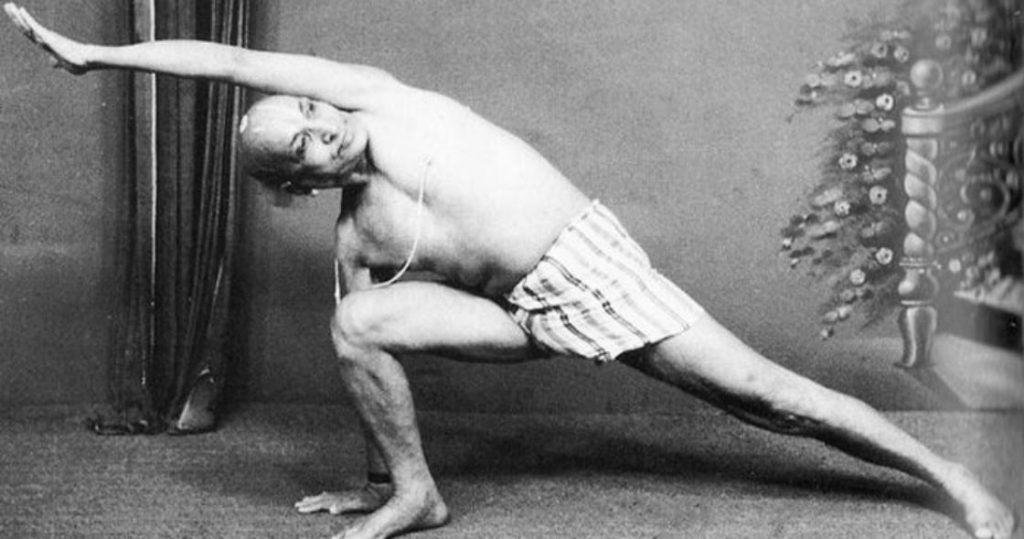
Life Story
T. Krishnamacharya was born on November 18, 1888, to an orthodox Iyengar family in present-day Karnataka, South India. He received upanayana, a Hindu ritual of initiation, at the age of six. Under his father’s stern guidance, he began learning to speak and write Sanskrit as well as chanting the Vedas.
After his father’s death, the family moved to Mysore.
Krishnamacharya spent much of his adolescence in India studying the six darsana or Indian philosophies: vaisesika, nyaya, samkhya, yoga, mimamsa, and vedanta.
He left Mysore at the age of eighteen to study logic, Sanskrit, and Mimamsa at Banaras University, also known as Varanasi, a highly esteemed North Indian centre of ancient learning.
He also attended the Patna University in Bihar after receiving a scholarship to study Ayurveda.
The Rise and Fall of Krishnamacharya’s Yogashala
Krishnamacharya’s life turned around when the Maharaja of Mysore, Krishna Raja Wadiyar IV visited Varanasi in 1926 and was impressed by Krishnamacharya’s demeanor and skills as a yoga therapist. The king invited him to teach him and his family in Mysore Palace.
Over the years, he not only became a trusted advisor to the King but was also sent around the country to promote the art of yoga through demonstrations and lectures.
It was under the guidance and patronage of the Maharaj of Mysore that Krishnamacharya was able to open his own Yogashala, an independent yoga institution, on 11 August 1933.
However, after the king died, his successor showed no interest in the expansion of yoga. And after India’s independence, Krishnamacharya struggled to find a stable source of income as well as students for his yogashala. And by 1950, the yogashala was ordered to be closed.
His Later Years
In 1952, he travelled to Madra, now Chennai, and got a job as a lecturer at Vivekananda College. There he got to opportunity to teach yoga to students from various backgrounds, which helped him develop and adapt his teachings to a student’s ability.
Krishnamacharya injured his hip at the age of 96. He refused surgery and instead treated himself by designing a practice that he could do in bed. He lived and taught in Chennai till he fell ill and died in 1989, at the age of 100.
Popularly known as the “Father of Modern Yoga”
Krishnamacharya is largely attributed as the architect of the Vinyasa style of yoga, also known as Vinyasa Krama Yoga, where you combine breath with movement. It was later termed Viniyoga by his son, T. K. V. Desikachar as he refined the approach to suit the needs of the students.
Tirumalai Krishnamacharya was also an ayurvedic healer, scholar, and yoga teacher from India. He is regarded as one of the most influential gurus of modern yoga and is sometimes referred to as “the father of modern yoga” due to his significant influence on the expansion of postural yoga.
While Krishnamacharya is renowned as a yogi in other parts of the world, he is best recognized in India as a healer who used both Ayurveda and yogic traditions to restore health and well-being to people he treated.
Yoga Makaranda (1934), Yogaasanagalu (c. 1941), Yoga Rahasya, and Yogavalli (Chapter 1 – 1988) are among his four yoga works, as well as various articles and literary pieces.
Influence on Indian Yoga
Due to his extensive contribution to the revival of yoga in India, Krishnamacharya is commonly known as the Father of Modern Yoga. Many well-known yoga gurus have studied under him and went on to create their techniques, with his teachings being the base of all methods.
The Yoga Sutras of Patanjali and the Yoga Yajnavalkya were the foundations of Krishnamacharya’s teachings. He believed that the path of yoga meant different things to different individuals and that each person should be taught in a way that he or she could understand.
Krishnamacharya emphasized the necessity of mixing breath exercises (pranayama) with yoga postures (asanas) and meditation (dhyana) while training someone on how to practice yoga.
The concept of kundalini was one of Krishnamacharya’s most unique teachings. According to him, it is not rising energy but an obstruction that keeps prana from rising.
Krishnamacharya was a well-respected scholar too. He studied philosophy, logic, religion, philology, and music in college and also had immense knowledge of orthodox Hindu rituals.
3. Paramahansa Yogananda (1893 – 1952)
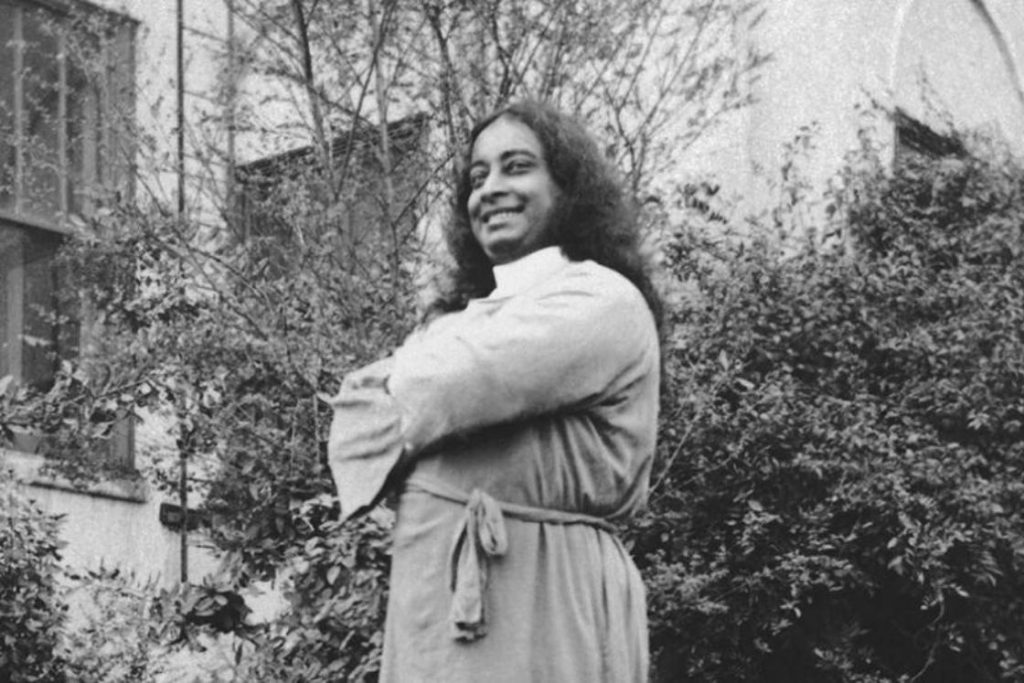
Life Story
Yogananda was born as Mukunda Lal Ghosh in Gorakhpur, Uttar Pradesh, India on January 5, 1893. Even during his childhood, he exhibited awareness and experience of the spirit that was far beyond the ordinary.
Due to this, he sought many Indian gurus and sages to find a teacher that could guide him in his spiritual quest. He also joined the Mahamandal Hermitage in Varanasi after finishing his initial education but soon left as he did not receive the guidance and knowledge on meditation and God-perception.
At the age of 17 in 1910, he met his guru Swami Sri Yukteswar Giri. For the next 10 years, he trained directly under him at his hermitages in Serampore and Puri, West Bengal. in July 1915, after graduation from college, he pledged to the monastic Swami order and took the name Swami Yogananda Giri.
Journey to America
In 1920, Yogananda undertook his first trip to Boston America after receiving a vision and a green signal from his guru and Great Guru, Mahavatar Babaji. There he spoke at International Congress in early October and also founded the Self-Realization Fellowship (SRF).
For the next 4 years, he taught and gave lectures in Boston, New York and other areas on the East Coast.
In 1925, he established the international center for Self-Realization Fellowship in Los Angeles, California, which would become the heart of spreading his teachings and ancient practices of yoga.
He stayed there till 1952, with a short gap between 1935-1936 when he travelled back to India, along with countries like Egypt, Italy, Greece, Palestine, Cairo, and Assisi.
It was also in this one year that he received the title Paramahansa, which means “supreme swan” and is said to be the highest title for spiritual attainment.
When he returned to America, he took residence in the SRF hermitage in Encinitas, California, where he started writing his acclaimed “Autobiography of a Yogi” amongst other writings.
In 1949, he became a naturalized U.S. Citizen and lived there until his demise on March 7, 1952.
Popularly Known For “Autobiography of a Yogi”
Yogananda is most popular for his book Autobiography of a Yogi where he has written in great detail about his spiritual experiences and life as he travelled to different parts of the world to spread the teachings of yoga.
Yogananda’s spiritual quest for enlightenment is chronicled in this book, which includes interactions with Mahatma Gandhi, eminent Indian scientist Sir Jagadish Chandra Bose, Nobel laureate in physics Sir C. V. Raman, and Nobel laureate in literature Rabindranath Tagore.
Additionally, he has also outlined the process of learning Kriya Yoga, which is the union with the infinite through certain rites and actions (kriyas). He is also credited with spreading the teaching of Kriya Yoga to the western world through his book.
There are many other books that he has published that take a spiritual context including “Man’s Eternal Quest”, “The Divine Romance”, “Journey to Self-realization”, “The Science of Religion”, etc.
Organization Founded
Yogananda established a boys’ school in Dihika, West Bengal, in 1917 that merged modern educational practices with yoga instruction and spiritual values. The school moved to Ranchi a year later.
The Yogoda Satsanga Society (YSS) of India (https://yssofindia.org/) later became the Indian arm of Yogananda’s American organization, Self-Realization Fellowship (SRF) (https://yogananda.org/).
YSS and SRF, both of which are non-profit organizations, have been instrumental in spreading and preserving the teachings of Yogananda.
Members of the SRF seek to learn that they are one with God. To do so, one must focus their attention on insight rather than on things that can be heard, seen, smelled, tasted, or touched. SRF members perform Kriya Yoga to focus their efforts on introspection. Brother Chidananda is the current and 5th president and spiritual head of YSS and SRF.
4. K. Pattabhi Jois (1915 – 2009)
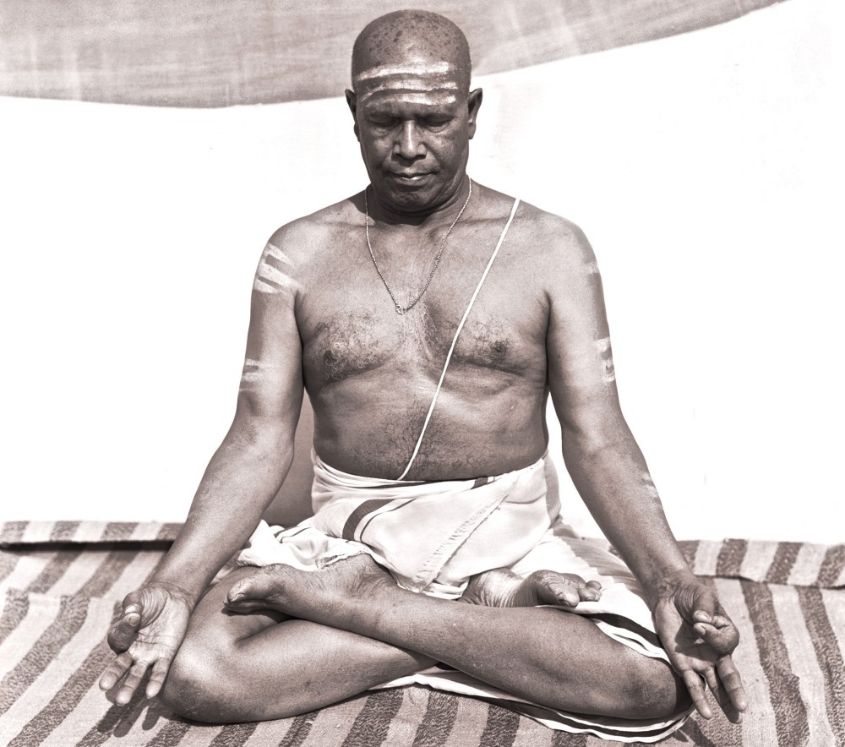
Life Story
Krishna Pattabhi Jois was born on July 26, 1915, in Karnataka, South India, into a Kannada Brahmin family.
Jois’ father was a landowner, astrologer, and priest. His father began teaching him Sanskrit and rituals when he was five years old, as it is customary for Brahmin males.
At the age of 12, he became a student of T. Krishnamacharya in 1927 when he attended his lecture and demonstration and studied under him for 2 years. They had to briefly part ways when Krishnamacharya left the palace but was later reunited with him in Mysore 2 years later.
Jois attended Krishnamacharya’s demonstrations and often taught classes in his absence. He also studies texts such as Patanjali’s Yoga Sutra, Hatha Yoga Pradipika, Yoga Yajnavalkya, and the Upanisads.
In 1927, Jois learned and studied the Yoga Korunta method. Yoga Korunta, as claimed by Krishnamacharya is a badly damages ancient text that has many portions missing, which he learned from a teacher named Rama Mohan Brahmachari for 7 years in the Himalayas. But since there is no physical proof of this text being seen by Jois, its authenticity is doubtful.
The Yoga Korunta method included practising pranayama, bandhas (core muscular and energetic locks), and drishti (visual focal points) were included along with asanas (postures) and vinyasas (connecting movements). This later served as the basis of the yoga method he developed.
Between 1937 to 1973, he also taught in the Sanskrit College and also held the title of Honorary Professor of Yoga at the Government College of Indian Medicine from 1976 to 1978.
In 1974, he travelled to South America to give a lecture in Sanskrit at an international yoga conference. Later in 1975, he stayed in Encinitas, California for 4 months which marks the beginning of the spread of Ashtanga Vinyasa Yoga in the US over the next 20 years.
Popularly Known For “Ashtanga Vinyasa Yoga”
K. Pattabhi Jois is credited with inventing the Ashtanga Vinyasa Yoga style which is energetic style and requires associating breath with movement. This yoga style is based on the learning of the ancient text “Yoga Korunta” which he studied under Rama Mohan Brahmachari in the Himalayas. This style of teaching has also come to be known as Mysore Style, referencing the city where it originated.
He also published a book, Yoga Mala in 1958 which was originally written in the Kannada language and later translated to English in 1999.
K. Pattabhi Jois is also known to be one of the few students of T. Krishnamacharya who have been instrumental in spreading modern Yoga in India and abroad and invented a new yoga style.
Organization Founded
In 1948, Jois established the Ashtanga Yoga Research Institute at the back of his home in Lakshmipuram, and later he opened a new school in Gokulam in 2002 when his students significantly increased.
He taught in this institute with his daughter and grandson R. Sharath Jois for the remainder of his life. Currently, Jois’s grandson, R. Sharath Jois, is the director of the K. Pattabhi Jois Ashtanga Yoga Institute (KPJAYI) (https://kpjayshala.com/) in Mysore.
5. B.K.S. Iyengar (1918 – 2014)
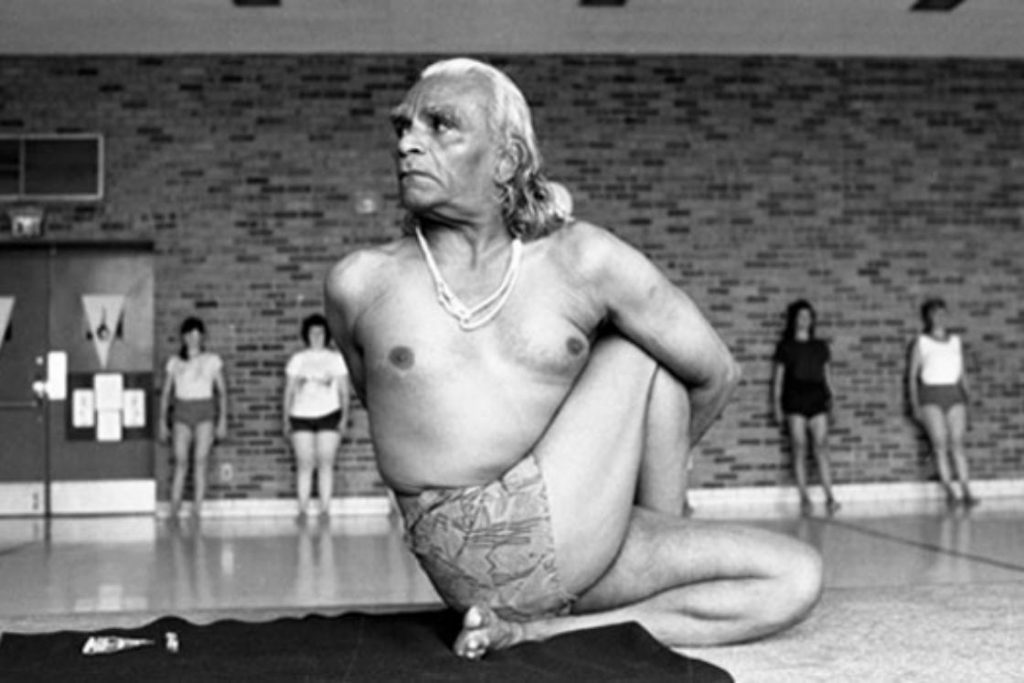
Life Story
Bellur Krishnamachar Sundararaja or popularly known as B.K.S. Iyengar was born into a poor family in Bellur, Karnataka, India on 14 December 1918. He had always been a sickly child since in his early years as he struggled with malaria, tuberculosis, typhoid fever, and general malnutrition.
At the age of 15, T. Krishnamacharya, who was his brother-in-law, asked him to come to Mysore where his health would get improved through yoga. He also saw and participated in the demonstrations given in the Mysore Palace. This left a positive and lasting impression on Iyengar.
By 1937, Iyengar was tasked to spread the teachings of yoga by Krishnamacharya and sent to Pune.
It is also noted that Iyengar had a troubled relationship with his guru as he did not give importance to teaching yoga and rather was tasked with household chores. When Krishnamacharya’s favourite pupil, Keshavamurthy, left the ashram, Iyengar started his training.
His journey to spreading yoga to the western world started when he first met the famous violinist Yehudi Menuhin in Bombay in 1952.
The story goes that Yehudi was tired and spared only 5 minutes to meet Iyengar. Iyengar advised him to lie in Savasana wherein Yehudi fell asleep for 1 hour. After waking up refreshed, he spent the next 2 hours with Iyengar.
He invited Iyengar to Switzerland in 1954 where he gifted him a watch. Post this, Iyengar regularly visited the west, with his first visit to the US being in 1956. There he gave several lectures and demonstrations over the years.
He stopped teaching in 1984, but remained active in the Iyengar Yoga community, teaching special classes, delivering seminars, and publishing books.
Popularly Known For “Iyengar Yoga”
Iyengar drew his pupils in by giving them exactly what they wanted: physical stamina and flexibility. After a scooter accident displaced his spine, he began experimenting with the use of supports to assist disabled people in practising Yoga. Practising with props such as chairs, bolsters, blocks, etc. to attain alignment along with flexibility came to be known as “Iyengar Yoga”.
Iyengar students used to call him “Guru Ji” out of love and respect.
Apart from his contributions to the field of Yoga, BKS Iyengar was also known for his various philanthropist activities.
Nature protection is crucial to Iyengar, who believes that all animals and birds should be protected.
Iyengar worked with the Multiple Sclerosis Society of India’s Pune unit to raise awareness about the disease.
Donations to Iyengar’s ancestral village of Bellur were his most important charitable effort. He transformed the village through the Bellur Trust Fund. He constructed a hospital, India’s first temple devoted to Patanjali, a free school, a secondary school, and a college for the children of Bellur and the surrounding villages.
Moreover, “Light on Yoga” is a famous and internationally acclaimed book written by Iyengar that has been translated into 17 languages. There are 13 more books on the philosophy of yoga and pranayama that he has also written.
Organization Founded
In memory of his late wife Ramamani, Iyengar established the Ramamani Iyengar Memorial Yoga Institute (https://rimyi.org/) in Pune in 1975. It is currently being managed by his son Prashant who serves as the director.
6. Maharishi Mahesh Yogi (1918 – 2008)
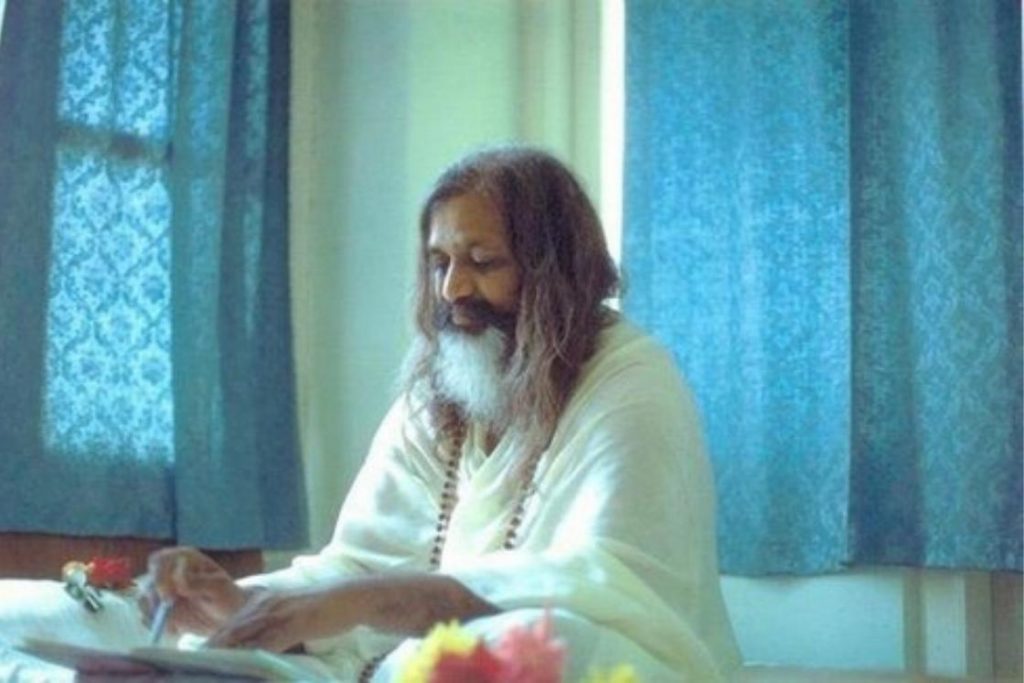
Life Story
Maharishi Mahesh Yogi’s real name and birth year are shrouded in uncertainty as it is the tradition of monks and ascetics to denounce family relations.
In 1941, he changed his identity to Bal Brahmachari Mahesh and became an administrative secretary to Swami Brahmananda Saraswati, the Shankaracharya of the Jyotir Math.
After earning Guru Dev’s trust, Brahmachari Mahesh was appointed as his secretary and favourite pupil. Swami Brahmananda Saraswati entrusted him with the bulk of his correspondence, and he was also dispatched to give public addresses on Vedic (scriptural) issues.
Mahesh graduated from Allahabad University with a degree in physics in 1942.
Brahmachari Mahesh stayed with Swami Brahmananda Saraswati till his death in 1953, after which he relocated to Uttarkashi, Uttarakhand, in the Himalayas, and lived in seclusion for two years.
At the end of his life, the Shankaracharya tasked him with travelling and teaching meditation to the populace.
Brahmachari Mahesh departed Uttarkashi in 1955 and began openly teaching Transcendental Deep Meditation, which he said was a traditional meditation technique learned from his master. Transcendental Meditation was the name given to the practice later.
He was also given the honorific title of “Maharishi,” which means “great sage,” at that time.
Between the period of 1958-1968, he extensively toured various countries such as Thailand, Malaya, Singapore, Hong Kong, Hawaii, Honolulu, San Francisco, Los Angeles, Boston, New York, London, Australia, and New Zealand to name a few.
There he gave lectures and inspired people to follow his technique of Transcendental Meditation.
Then from the period between 1968-1990, at his new worldwide headquarters in Seelisberg, Switzerland, he would halt his public activities and begin training TM teachers. Throughout the 1980s, the organization grew, and his meditation technique attracted more celebrities.
The Maharishi moved his headquarters from Seelisberg, Switzerland, to Vlodrop, the Netherlands, in 1990, and named it Maharishi European Research University (MERU), Holland. He mostly communicated with the public via video and the internet during his time in Vlodrop.
In Maastricht, Netherlands, the Maharishi is thought to have made his final public appearance in 1991. He suffered from kidney and pancreatic failure later in the year.
The Maharishi died quietly in his sleep on February 5, 2008, at his home in Vlodrop, Netherlands, of natural causes.
The Maharishi’s Allahabad ashram in India, which overlooks the meeting of the Ganges and Yamuna rivers, performed the cremation and death procedures.
Maharishi and Beatles
When the Maharishi became the spiritual guru of the Beatles in 1967, his fame grew and his movement became more well-known. Following the Beatles’ endorsement of TM, the Maharishi was featured on the covers of American magazines like Life, Newsweek, Time, and others in 1967 and 1968.
The Beatles’ visit to the Maharishi’s ashram fell on the same day as a thirty-person Transcendental Meditation teacher training course, which was in progress when they arrived.
Popularly Known For “Transcendental Meditation (TM)”
Maharishi Mahesh Yogi is most known for establishing and popularising Transcendental Meditation (TM), as well as being the founder and guru of a global organization that has been labelled as both a “new religious movement” and a “non-religious organization”.
He founded the TM-Sidhi program in the late 1970s, intending to improve practitioners’ mind-body relationships through techniques like Yogic flying.
The Maharishi rose to prominence as the guru of the Beatles, the Beach Boys, and other superstars in the late 1960s and early 1970s.
The Maharishi is also credited with the application of research to investigate the physiological effects of Transcendental Meditation and the development of higher states of consciousness, both of which were previously considered mysticism.
The Maharishi is the author of over twenty publications on Transcendental Meditation and Maharishi Vedic Science.
Health clinics, mail-order health supplements, and organic farms were founded by Maharishi, his family, and close colleagues.
Organization Founded
Maharishi Foundation USA teaches Transcendental Meditation in the United States. (https://www.tm.org/)
The Students International Meditation Society, AFSCI, World Plan Executive Council, Maharishi Vedic Education Development Corporation, and Global Country of World Peace were among the other non-profit organizations.
Tony Nader is Maharishi Mahesh Yogi’s successor and the leader of the Global Country of World Peace.
7. Swami Rama (1925 – 1996)
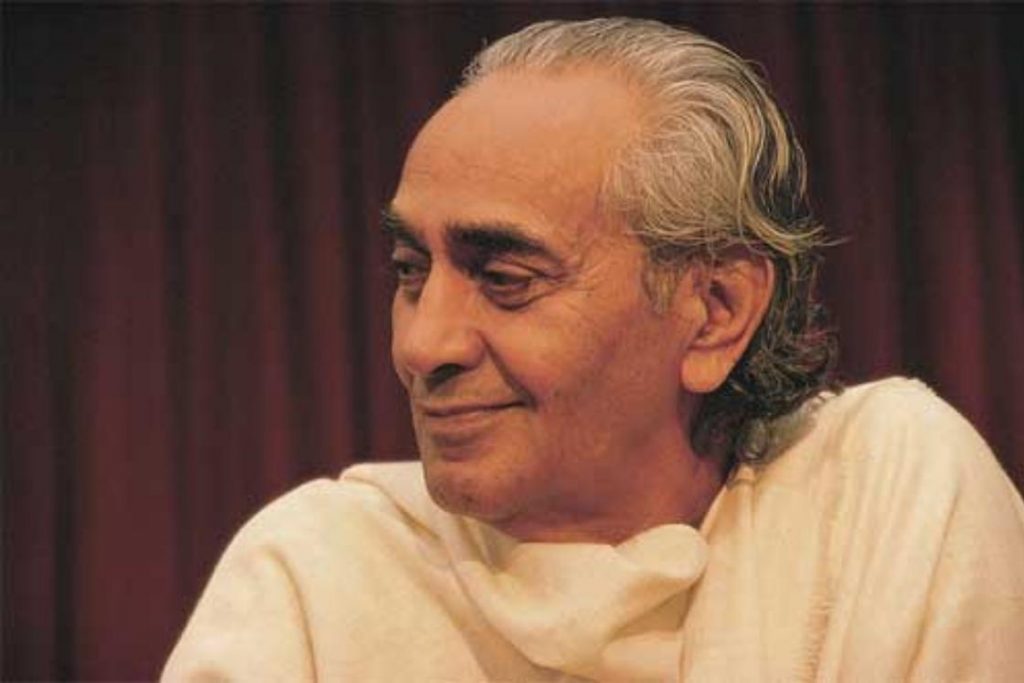
Life Story
Swami Rama was born in the village of Toli in the Garhwal Himalayas as Brij Kiore Dhasmana or Brij Kiore Kumar, a northern Indian Brahmin family.
He said that his particular teacher or master, Sri Madhavananda Bharati, nurtured him deep in the Himalayan monasteries and holy caves.
He also claimed to have earned degrees from an Indian school of homeopathy, the University of Hamburg, the University of Utrecht, and lastly the University of Oxford.
It has been claimed in his official biography, that he became the Shankaracharya or spiritual head of Karvirpitham located in Karnataka, South India, when he was 28 years old, after exhibiting significant knowledge of ancient texts and occupying the position from 1949 to 1952.
He moved to the United States in 1969 and gave talks at temples and churches, as well as taught Hatha yoga in YMCAs and private houses.
He went on to become recognized for his ability to regulate his body in yoga Nidra, and he wrote several books, including the autobiographical Living with Himalayan Masters.
Popularly Known For “Himalayan Institute of Yoga Science”
He became the first yogi from India to be researched by a group of western scientists.
Swami Rama’s yoga Nidra powers were tested, and he was found to be able to produce distinct brain waves at command.
He also halted his heart from pumping blood for 17 seconds in another experiment.
A New York Times journalist gave him a reputation for obtaining amazing psychosomatic states, which considerably increased his followers.
Swami Rama wrote many books about his journey to become a yogi, which was published in India and the United States. He also talks about yoga and meditation’s philosophy, practice, and advantages.
Living With Himalayan Masters is his most well-known work.
Organization Founded
He started the first Himalayan Institute of Yoga Science and Philosophy (https://himalayaninstitute.org/) in Kanpur, India, in 1966; in 1971, he opened a branch in Glenview, Illinois, and it is presently located in Honesdale, Pennsylvania.
The Himalayan Institute aims to inspire, educate, and empower those who want to reach their greatest potential. Pandit Tigunait, the spiritual head of the Himalayan Institute, is Swami Rama’s successor.
8. Sri Sri Ravi Shankar (1956 – present)
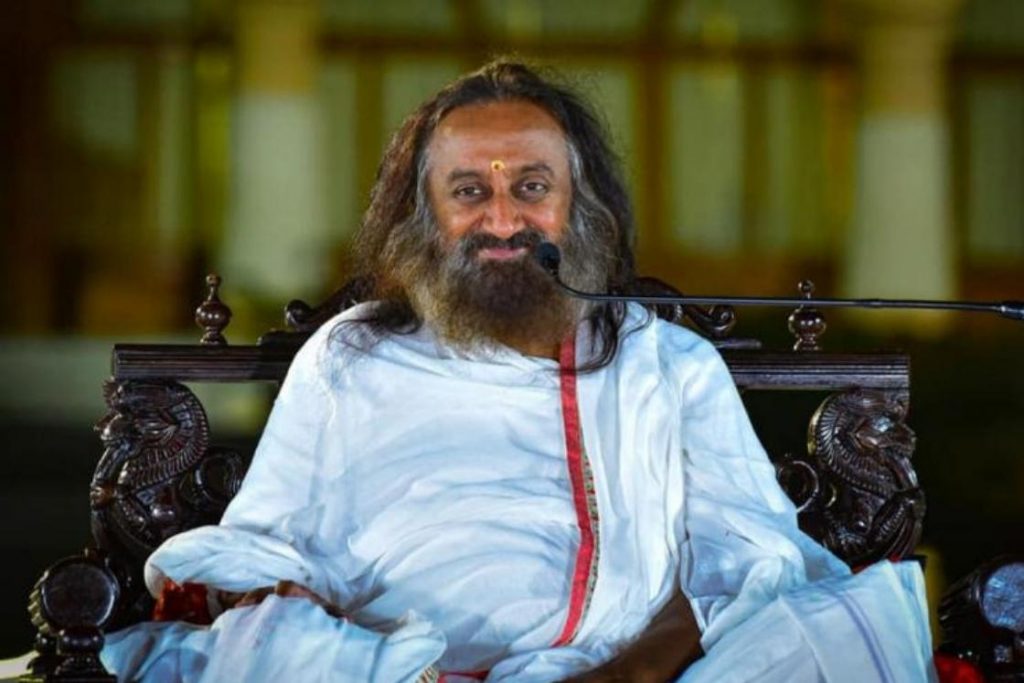
Life Story
Ravi Shankar is a spiritual guru of India who was born in Papanasam, Tamil Nadu. He was given the name “Ravi” meaning “sun” and “Shankar” after Adi Shankara, an eighth-century Hindu saint.
Sudhakar Chaturvedi, a Vedic scholar from India and a close acquaintance of Mahatma Gandhi, was Ravi Shankar’s first teacher.
He graduated from Bengaluru University’s St. Joseph’s College with a Bachelor of Science degree. Shankar traveled with his second guru, Maharishi Mahesh Yogi, after graduation, giving presentations and organizing Vedic science conferences, as well as establishing Transcendental Meditation and Ayurveda institutes.
Shankar began a series of practical and experiential spirituality seminars around the world in the 1980s.
He left the Transcendental Meditation (TM) movement in 1981 and created the Art of Living Foundation.
Shankar taught the first Art of Living course in Switzerland in 1983. He traveled to Apple Valley, California, in the United States in 1986 to teach the first course in North America.
Popularly Known For “Art of Living Foundation”
Sri Sri Ravi Shankar is mostly known for his organization The Art of Living which he founded in 1981. It is a non-profit humanitarian and educational organization run entirely by volunteers.
Another aspect that he is known for is The Sudarshan Kriya breathing technique.
In this technique, meditation, and yoga are used in their stress-reduction and self-development programs. This method is covered extensively in Art of Living classes.
His thoughts on spirituality are also widely acclaimed.
Spirituality, according to Shankar, is defined as the promotion of human virtues such as love, compassion, and excitement. It has no religious or cultural boundaries. As a result, everyone can participate.
He believes that the spiritual relationship we share as members of the human family is more important than any differences in nationality, gender, religion, profession, or other traits.
Organization Founded
The Art of Living Foundation (https://www.artofliving.org/in-en) has more than 156 locations around the world. Using breathing methods, meditation, and yoga, Art of Living offers a variety of stress-reduction and self-development programs.
9. Jaggi Vasudev (Sadhguru) (1957-present)
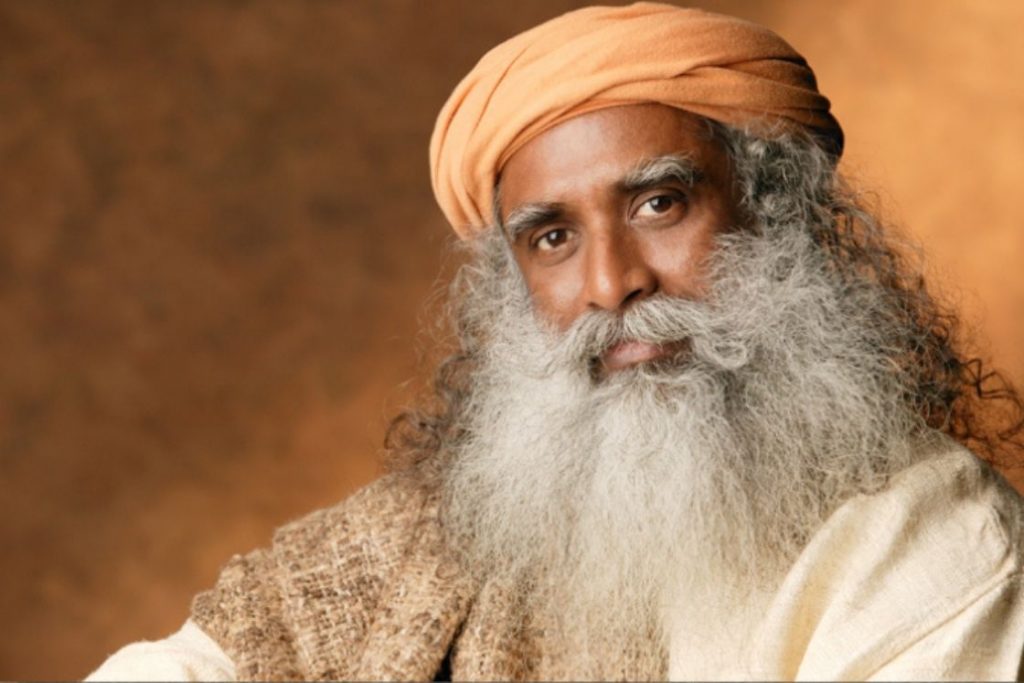
Life Story
Jagadish Vasudev was born in Mysore, Karnataka, India, on September 3, 1957. Throughout his youth, Vasudev received regular yoga instruction from Malladihalli Raghavendra, although having no spiritual goals.
Vasudev attended Demonstration School and Mahajana Pre-University College in Mysore. He earned a bachelor’s degree in English from the University of Mysore.
He started his career with a poultry farm in Mysore and also subsequently got into the construction business with a company named Buildaids. At the age of 25, he rented his business to his friend and set out to travel and explore.
From the year 1983, he started teaching yoga across Karnataka and Hyderabad, travelling via his motorcycle. He survived from the money earned through his poultry farm business and other donations received from his yoga students.
Popularly Known For
Sadhguru is known more as a spiritual leader who has authored several books. His most popular yoga practices include Shambhavi Mahamudra, Surya Kriya, Bhuta suddhi, Isha Hatha Yoga, etc.
He has been invited as a public speaker in various forums such as the United Nation’s Millennium World Peace Summit, the British House of Lords, and the Massachusetts Institute of Technology, and the International Institute for Management Development.
Some other projects of his include:
- Project GreenHands (PGH)
- Action for Rural Rejuvenation
- Isha Vidhya (an education initiative)
- Rally for Rivers
- The Cauvery Calling
- Save soil movement
Organization Founded
Sadhguru founded the Isha Foundation (https://isha.sadhguru.org/in/en), a spiritual and educational organization based near Coimbatore, in 1992 as a forum for his spiritual and educational pursuits.
Under the name “Isha Yoga,” the organization offers yoga programs and is “nearly exclusively” administered by volunteers.
The headquarters of the Isha Foundation is in an ashram in Coimbatore, Tamil Nadu, India, near the foothills of the Velliangiri Mountains. Until now, he has been its head.
10. Baba Ramdev (1965 – present)
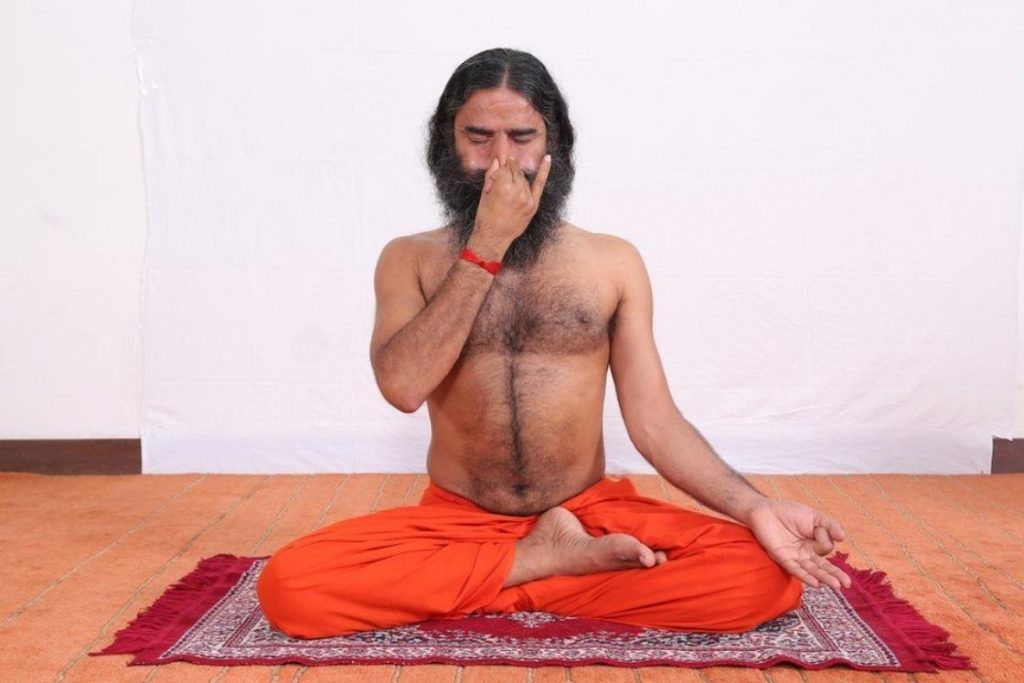
Life Story
Baba Ramdev or Swami Ramdev was born as Ram Kisan Yadav to a farmer couple in Haryana and hails from the Arya Samaj tradition.
He received his education till the 8th standard post when he fled his house to pursue his study in Indian scripture, Yoga, and Sanskrit in the gurukul system. He preferred them as they taught Vedic principles in the traditional manner.
He studied in Arsh Gurukul Khanpur for 3 years under the guidance of Guru Pradyumna and took the name Ramkrishna. He also offered free yoga training to the villagers in this gurukul.
This is also where he met Balkrishna, who would later become his associate in his various ventures.
Later, he studies under Acharya Baldevji, who was the Arya Samaj chief in Gurukul Kalwa. The name Ramdev was also conferred to him by acharya. Ramdev also learned yoga from Guru Karamvir, another Arya Samaji.
When he was 25, he adopted the life of sanyasi or renunciation and began teaching yoga.
He then relocated to Haridwar, Uttarakhand, where he researched ancient Indian scriptures at Gurukul Kangri Vishwavidyalaya and practiced self-discipline and meditation.
Ramdev’s major yoga center, Yog Gram, is located in Haridwar, where he practices and teaches yoga in an auditorium that is also shown on television.
Popularly Known For
Baba Ramdev is a prominent figure in Yoga and Ayurveda in India. He is also known for his ardent propagation of kapalbhati pranayama which he has demonstrated on TV channels.
Since 2002, Ramdev has been organizing and hosting huge yoga camps, and his yoga lessons have been televised on numerous television stations.
He and his colleague Balkrishna co-founded Patanjali Ayurved Ltd. to market his ayurvedic products to the masses through Patanjali outlets.
Ramdev had been invited to give a speech on poverty eradication at a United Nations conference in 2006 by Kofi Annan.
Organization Founded
The Patanjali Yogpeeth (https://divyayoga.com/) was established to promote and practice Yoga and Ayurveda. Patanjali Yogpeeth I and Patanjali Yogpeeth II, both in Haridwar, Uttarakhand, are its two Indian campuses. UK, US, Nepal, Canada, and Mauritius are among the other countries represented.
The Patanjali Yogapeeth has Ramdev as its Vice-Chancellor.
